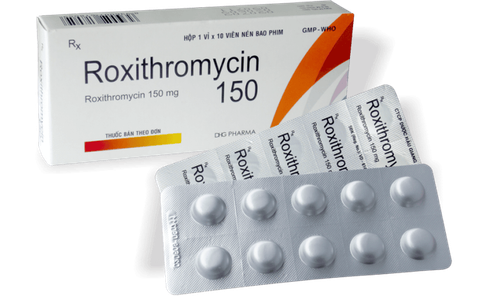1. What are the effects of Curam?
1.1. Indications
"What is Curam 1000?" Curam contains the active antibiotic ingredient amoxicillin in combination with clavulanic acid and is available in two dosages: Curam 1000mg (875mg/125mg) and Curam 625mg (500mg/125mg). Curam is a beta-lactam antibiotic that is indicated to treat the following diseases:
- Acute exacerbation of chronic bronchitis, acute otitis media;
- Acute bacterial rhinosinusitis (ABRS) (confirmed diagnosed by Otorhinolaryngologist);
- Community-acquired pneumonia;
- Pyelonephritis, cystitis;
- Skin and soft tissue infections, such as cellulitis, severe gum abscess, and local wound infection by animal bites;
- Bone and joint infections, particularly osteomyelitis.
1.2. Pharmacodynamics
Amoxicillin is classified as a synthetic penicillin antibiotic and inhibits one or more enzymes involved in the peptidoglycan biosynthesis pathway of the bacterial cell wall. This inhibitor prevents peptidoglycan formation, weakening the cell wall and resulting in cell lysis and death.
Resistant bacteria produce the Beta-lactamase enzyme, which rapidly degrades amoxicillin. As a result, amoxicillin alone does not exhibit activity against bacteria that generate this enzyme.
Clavulanic acid, a Beta-lactam compound structurally related to penicillin, inhibits certain Beta-lactamase enzymes. This action restores the antibacterial activity of amoxicillin. However, clavulanic acid itself lacks clinically significant antibacterial effects.
Bacteria can resist amoxicillin/clavulanic acid via two mechanisms:
- Production of beta-lactamase enzymes resistant to clavulanic acid (e.g., classes B, C, D);
- Modification of penicillin-binding proteins (PBPs) reduces the affinity of the antibacterial drug for the target. Efflux mechanisms or bacterial impermeability can lead to or contribute to bacterial resistance (especially against gram-negative bacteria).
1.3. Pharmacokinetics
- Absorption: Both amoxicillin and clavulanic acid are rapidly absorbed orally, with bioavailability at approximately 70%. Peak plasma levels occur around 1 hour after administration. Absorption improves when taken at the beginning of a meal.
- Distribution: Approximately 25% of clavulanic acid and 18% of amoxicillin bind to plasma proteins. Amoxicillin’s apparent volume of distribution (Vd) is 0.3–0.4 L/kg, while clavulanic acid’s is around 0.2 L/kg. Both components distribute to abdominal tissues, bile, muscles, fat, and synovial fluid but are inadequately distributed to cerebrospinal fluid.
- Metabolism: Amoxicillin is partially excreted as inactive penicilloic acid (10–25% of the dose). Clavulanic acid undergoes significant metabolism and is eliminated in urine, feces, and exhaled CO2.
- Excretion: Amoxicillin is excreted mainly by the kidneys; clavulanic acid is excreted by both the kidneys and non-renal routes. The mean half-life of both active substances is 1 hour, and the mean total clearance is 25 liters/hour in healthy subjects. 60-70% of amoxicillin and 40-65% of clavulanic acid are excreted unchanged in the urine within 6 hours after taking a single dose of 250 mg/125 mg or 500 mg/125 mg tablets.
2. Dosage and Administration
2.1. Administration
Curam tablets are taken orally. Administer at the beginning of a meal for optimal absorption and reduced gastrointestinal side effects. Intravenous formulations may be used to initiate treatment.
2.2. Dosage
Dosage varies based on formulation (Curam 625 1000 mg or Curam 1000mg), causative organism, severity, infection site, patient age, weight, and condition:
- Adults and children >40kg: Take one 625mg tablet three times daily. For children, consider formulations like suspensions or powders. Clinical data for children under two years is limited; recommended dosage is 40mg/10mg/kg/day;
- Elderly: No dosage adjustmeadjustment is;
- Renal impairment: Adjust dosage according to amoxicillin clearance levels; no adjustment is necessary for creatinine clearance >30 mL/min;
- Hepatic impairment: Use cautiously with regular liver function monitoring.
3. Side Effects of Curam 625 mg and Curam 1000 mg
Some side effects that may occur when using the antibiotic Curam are as follows:
- Very common (≥1/10): diarrhea;
- Common (≥1/100 to <1/10): Candida infections of mucous membranes and skin; nausea;
- Uncommon (≥1/1,000 to <1/100): headache, dizziness, vomiting, elevated AST/ALT, rash, hives, pruritus;
- Rare (<1/10,000): reversible leukopenia, thrombocytopenia, erythema multiforme;
- Unknown frequency: overgrowth of resistant bacteria, reversible agranulocytosis, haemolytic anaemia, prolonged bleeding times, angioedema, anaphylaxis, serum sickness-like syndrome, Stevens-Johnson syndrome, toxic epidermal necrolysis, interstitial nephritis, crystalluria.
4. Precautions when using Curam
4.1. Contraindications
Coram is contraindicated in the following cases:
- Hypersensitivity to any component or penicillin group;
- History of severe hypersensitivity (e.g., anaphylaxis) to beta-lactams.
4.2. Warnings and Precautions
Before treatment with Coram, patients need to carefully treat previous hypersensitivity reactions to penicillin, cephalosporin, or drugs in the beta-lactam group.
- Serious and occasionally fatal hypersensitivity reactions have been reported in patients treated with penicillins, including those with a history of hypersensitivity to penicillins and those with a history of allergies. If an allergic reaction occurs, treatment with amoxicillin/clavulanic acid should be discontinued and an alternative treatment regimen instituted. In cases where the infection is proven to be caused by bacteria susceptible to amoxicillin, consideration should be given to switching from amoxicillin/clavulanic acid to amoxicillin in accordance with official guidance.
- Curam is not suitable for use in patients at high risk of pathogens with presumed resistance to beta-lactams not mediated by beta-lactamases sensitive to clavulanic acid inhibition. It should not be used to treat penicillin-resistant S. pneumoniae.
- Seizures may occur in patients with impaired renal function or in patients taking high doses of the drug. Avoid the use of amoxicillin/clavulanic acid in suspected infectious mononucleosis because of the occurrence of a morbilliform rash associated with this condition following the use of amoxicillin.
- Concomitant use of amoxicillin and allopurinol may increase the risk of skin reactions. Prolonged use of the drug may result in the overgrowth of drug-resistant bacteria.
- Acute generalised exanthematous pustulosis (AGEP) with symptoms of generalised erythema, fever, and pustules may occur with the use of Curam. In this case, the drug should be discontinued and any form of amoxicillin is contraindicated.
- Use caution in patients with symptoms of liver failure.
- Periodic assessment of organ system function, including liver, kidney, and haematopoietic systems, should be performed during long-term therapy. In patients with renal impairment, dosage should be adjusted according to the degree of renal impairment.
- In patients with reduced urine output, very rarely crystalluria has been observed (mainly with parenteral therapy). In cases of treatment with high doses of amoxicillin, it is necessary to maintain adequate fluid intake as well as urine output to help reduce the possibility of amoxicillin crystalluria (patients with bladder catheters should maintain regular patency checks).
- Ability to drive and operate machinery: There are currently no studies recording adverse reactions of the drug on the ability to drive, operate machinery... However, patients may experience side effects such as dizziness, allergies, convulsions, etc.
- Pregnant women: Animal studies have shown that the drug does not cause direct or indirect harmful effects on pregnancy or embryonic development. Data on drug use in pregnant women do not show an increased risk of congenital malformations. However, the use of the drug in pregnant women should still be limited.
- Nursing mothers: The drug is excreted in breast milk and may cause diarrhea and fungal infections of the mucous membranes in breastfed infants. Therefore, breastfeeding should be discontinued during treatment with Coram.
To arrange an appointment, please call HOTLINE or make your reservation directly HERE. You may also download the MyVinmec app to schedule appointments faster and manage your reservations more conveniently.








